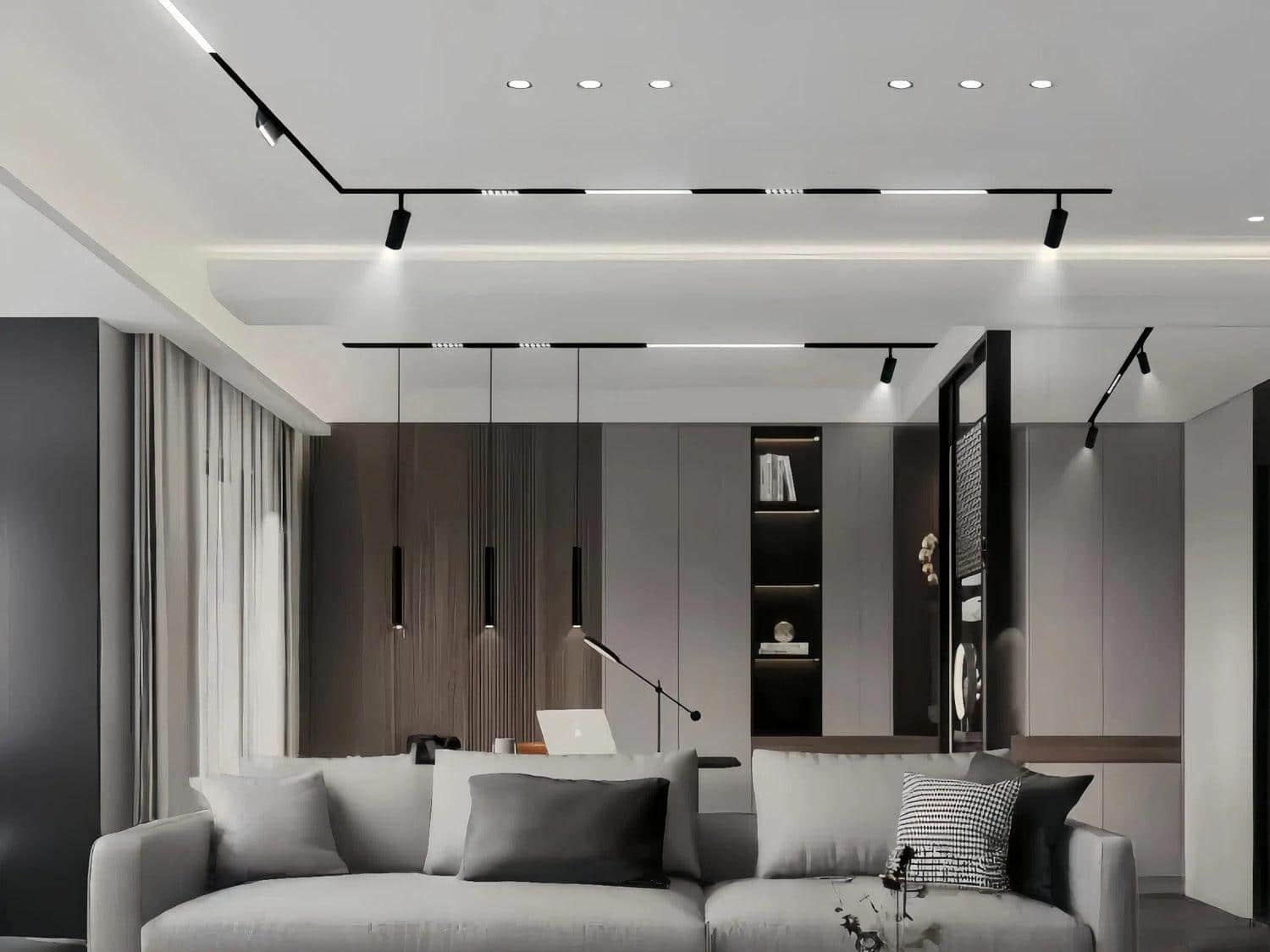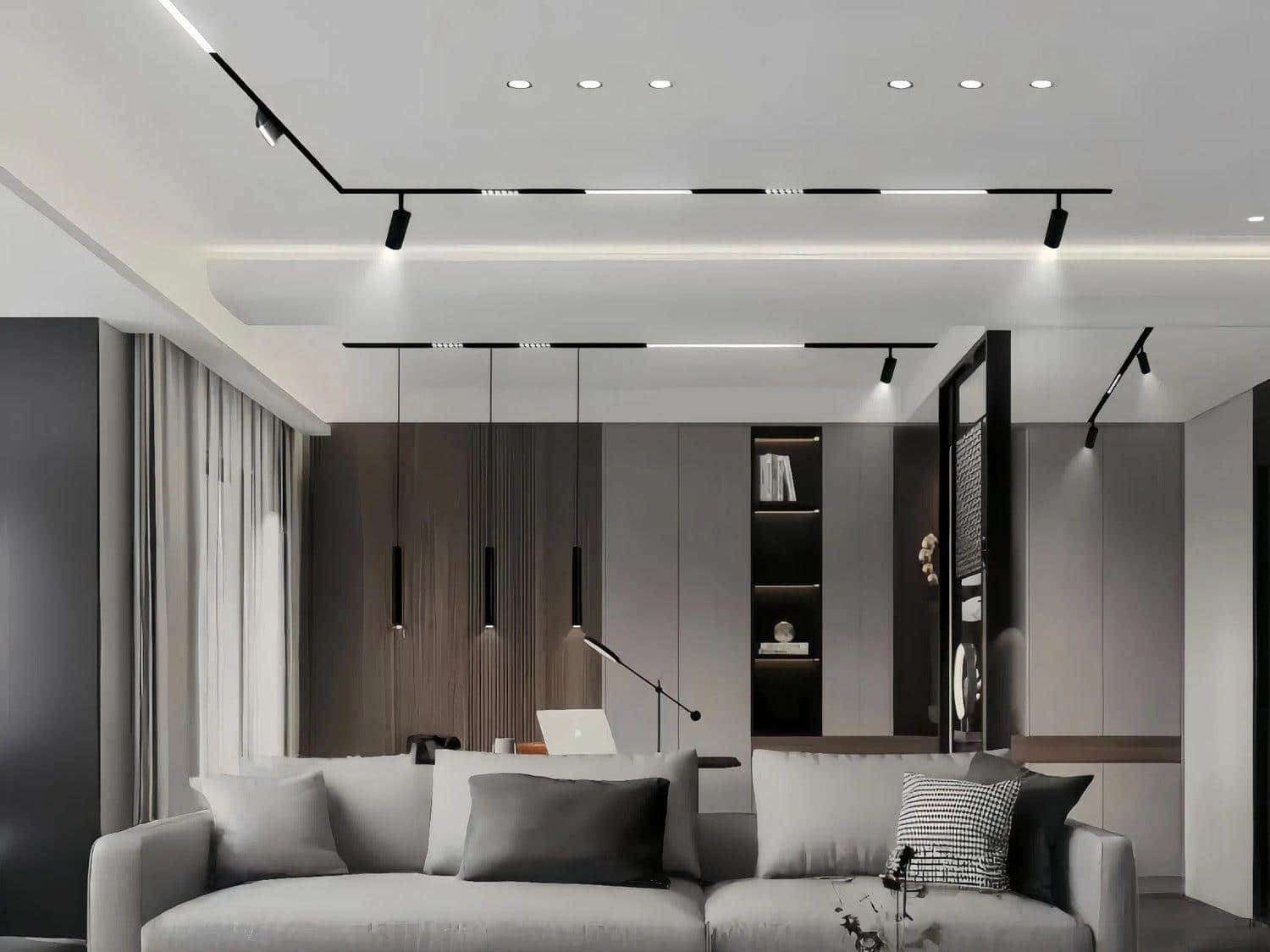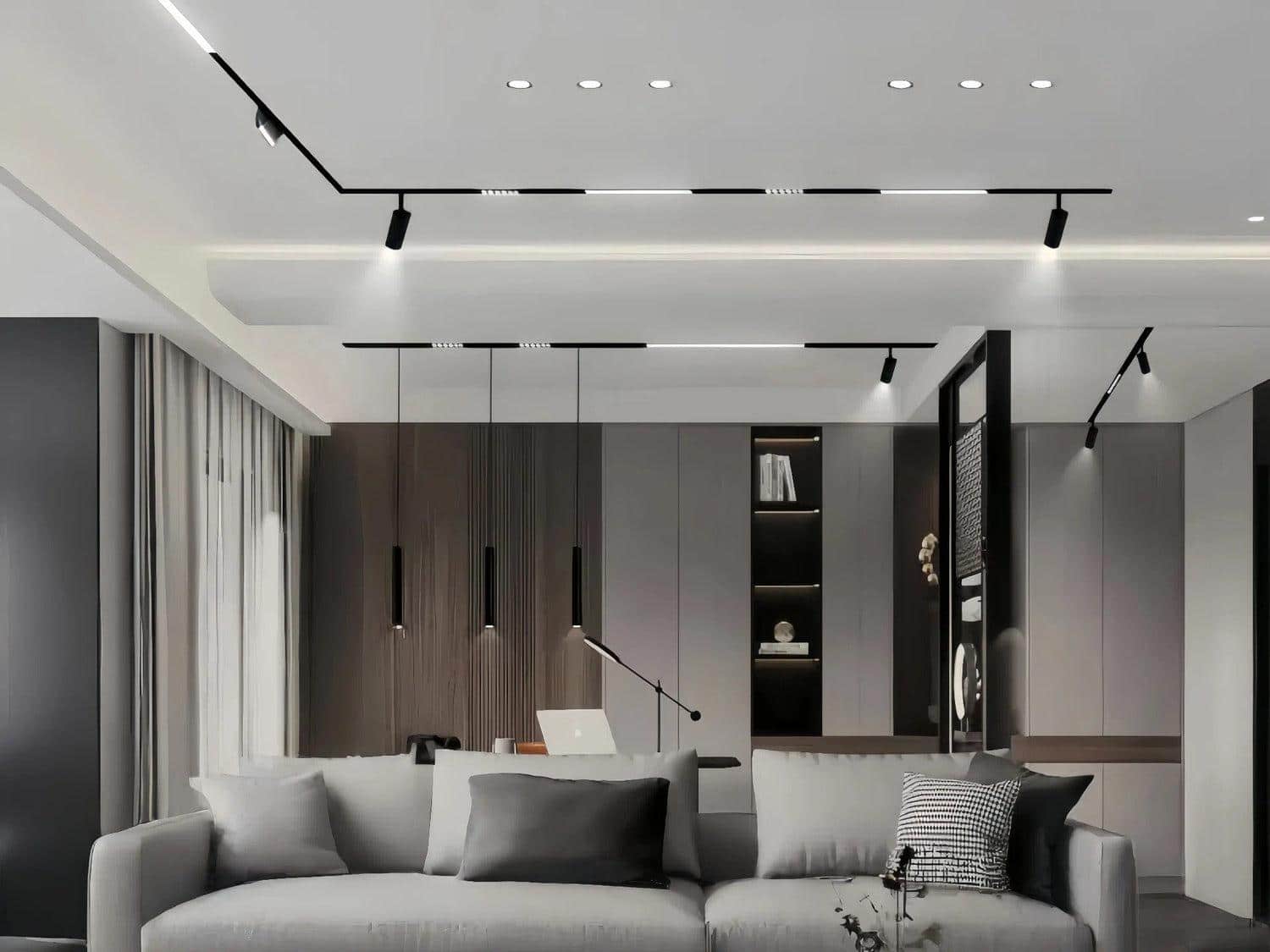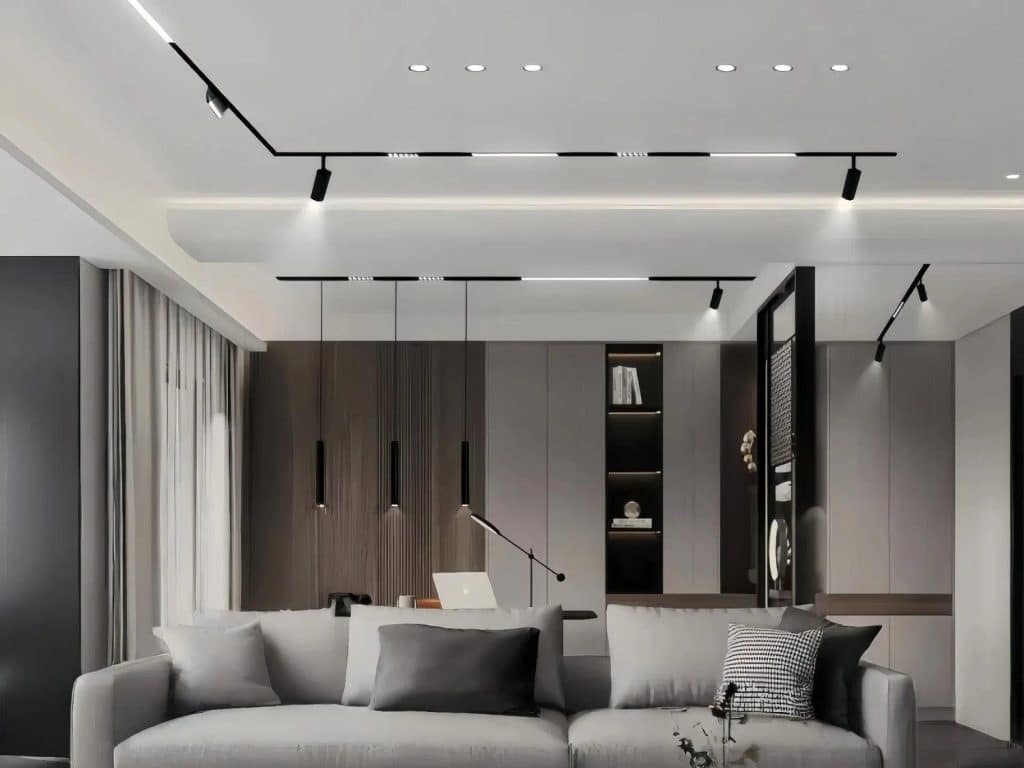When it comes to illuminating spaces prone to moisture like bathrooms, kitchens, and covered patios, standard lighting fixtures simply won’t cut it. Damp-rated track fixture lights offer a sophisticated solution that combines safety with style, allowing you to brighten these challenging areas without compromising on design or functionality. These specialized fixtures are engineered to withstand humidity and condensation, making them essential for any home where moisture meets modern lighting needs.
Beyond their practical moisture-resistant properties, damp-rated track fixture lights systems deliver remarkable versatility in directing light exactly where you need it. Whether you’re highlighting architectural features in a steamy bathroom, creating ambient lighting in your kitchen, or setting the mood on an enclosed porch, these fixtures adapt to your vision while protecting against the damaging effects of moisture that would quickly deteriorate ordinary lighting.
Homeowners, interior designers, and renovation enthusiasts looking to upgrade moisture-prone spaces will find that damp-rated track fixture lights address both safety concerns and aesthetic aspirations. If you’ve been struggling with inadequate lighting in humid areas or worried about the longevity of your current fixtures, understanding how these specialized systems work can transform your approach to interior illumination.
Understanding Damp-Rated Track Fixture Lights
Damp-rated track fixture lights refer to fixtures specifically designed and tested to operate safely in environments where moisture is present but not in direct contact with water. Unlike wet-rated fixtures that can withstand rain or direct spray, damp-rated systems are engineered for indoor spaces with elevated humidity levels, such as bathrooms with showers, steamy kitchens, laundry rooms, and covered outdoor areas like enclosed patios or three-season porches. The “damp” designation comes from rigorous testing standards set by organizations like Underwriters Laboratories, which certify that these fixtures can handle condensation, humidity, and temperature fluctuations without electrical hazards or premature deterioration.

The construction of damp-rated track fixture lights incorporates sealed electrical components, corrosion-resistant materials, and specialized gaskets that prevent moisture infiltration into critical areas. These protective features distinguish them from standard dry-rated fixtures, which would quickly corrode, short-circuit, or become fire hazards when exposed to persistent humidity. The track systems themselves are manufactured from materials like aluminum or stainless steel that resist rust, while the fixture housings use powder-coated finishes or sealed glass to protect internal wiring and sockets.
Understanding the distinction between damp-rated and other ratings is crucial for both safety and compliance with building codes. Installing standard lighting in moisture-prone areas not only voids warranties but also creates genuine safety risks for your household. Damp-rated fixtures provide peace of mind while maintaining the adjustable, directional lighting capabilities that make track systems so popular for accent lighting, task illumination, and creating visual interest in challenging spaces where traditional fixtures fall short.
The Benefits of Damp-Rated Track Fixture Lights
The primary advantage of damp-rated track fixture lights lies in their exceptional durability when exposed to moisture-heavy environments. These fixtures are built to resist the corrosive effects of humidity that would quickly degrade standard lighting, meaning you won’t face the frustration of replacing corroded tracks, rusted components, or malfunctioning electrical connections every few years. The specialized sealing and corrosion-resistant materials extend the operational lifespan significantly, often lasting decades rather than years in bathrooms and kitchens where condensation is a daily occurrence.

Beyond longevity, damp-rated track systems provide unmatched flexibility in directing light precisely where you need it most. In a bathroom, you can angle fixtures to illuminate vanity areas without creating harsh shadows, while in kitchens, adjustable heads let you spotlight countertops for food preparation or highlight architectural details like backsplashes and cabinetry. This adaptability means you’re not locked into fixed lighting positions, allowing you to reconfigure your illumination as your needs or décor evolve without reinstalling entire fixture systems.
Safety represents another compelling benefit that shouldn’t be overlooked. Damp-rated fixtures meet stringent electrical codes specifically designed to prevent short circuits, electrical fires, and shock hazards in moisture-prone areas. This compliance not only protects your household but also ensures your home meets inspection requirements if you’re selling or refinancing. The peace of mind knowing your lighting system won’t become a liability during steamy showers or while cooking is invaluable, particularly in homes with children or elderly residents who may be more vulnerable to electrical accidents.
How to Choose the Right Damp-Rated Track Fixture Lights
Selecting the appropriate damp-rated track fixture lights begins with accurately assessing your space’s moisture levels and lighting requirements. Measure the room dimensions to determine how many track feet you’ll need, keeping in mind that most systems accommodate multiple fixtures per track section. Consider the ceiling height as well—higher ceilings may require fixtures with greater lumen output or adjustable stems to bring light closer to functional areas. Evaluate whether you need focused task lighting for specific zones like vanities or countertops, or broader ambient illumination for general room lighting.

The fixture style should complement your existing décor while meeting functional demands. Modern track systems come in finishes ranging from brushed nickel and matte black to oil-rubbed bronze, allowing you to match hardware throughout your space. Pay attention to the bulb type compatibility—LED-compatible tracks offer energy efficiency and reduced heat output, which is particularly beneficial in already-warm, humid environments. Check the maximum wattage ratings and whether the system supports dimmable bulbs if you want adjustable brightness levels for different times of day or activities.
Finally, verify that any fixture you’re considering carries proper damp-rating certification from recognized testing organizations, clearly marked on the packaging or product specifications. Manufacturers like KIVENLIGHTING and others in the lighting industry clearly label their damp-rated products with UL or ETL certification marks to help consumers identify compliant fixtures. Don’t assume all track lighting marketed for bathrooms or kitchens meets these standards—confirm the rating explicitly matches your installation environment to ensure compliance with local electrical codes and maintain warranty coverage.
Designing with Damp-Rated Track Fixture Lights
Incorporating damp-rated track fixture lights in home design opens creative possibilities that standard fixtures can’t match in moisture-prone spaces. For contemporary bathrooms, sleek black or brushed nickel tracks with minimalist cylindrical heads create clean lines that complement frameless glass showers and floating vanities. Position tracks parallel to the vanity mirror to eliminate shadows on faces, or install them perpendicular to highlight textured tile walls and create depth. In modern kitchens, matte black tracks with exposed Edison-style LED bulbs add industrial charm while directing light onto marble countertops and stainless appliances, creating both functional task lighting and visual drama.

Traditional and transitional spaces benefit equally from thoughtful track lighting integration. Oil-rubbed bronze tracks with bell-shaped glass shades bring vintage elegance to classic bathrooms with clawfoot tubs and pedestal sinks, while the adjustable nature lets you spotlight architectural details like wainscoting or decorative molding. In farmhouse-style kitchens, whitewashed or antique brass tracks coordinate beautifully with shiplap walls and butcher-block counters, providing flexible illumination for both cooking tasks and displaying collections on open shelving. The key is selecting fixture finishes and head styles that echo other hardware in the room—cabinet pulls, faucets, and towel bars—to create cohesive visual flow.
Real-world applications demonstrate the transformative power of strategic track placement. A narrow galley bathroom gains dimension when tracks run lengthwise along the ceiling, with adjustable heads angled to wash walls with light and make the space feel wider. One homeowner installed L-shaped tracks in their master bathroom, positioning fixtures to illuminate both the double vanity and a freestanding soaking tub, creating distinct lighting zones within a single system. In a coastal-themed kitchen with high humidity from ocean proximity, white tracks with globe fixtures reinforced the breezy aesthetic while providing essential moisture protection. Another designer used curved track sections in a spa-inspired bathroom to follow the contour of a barrel-vaulted ceiling, demonstrating that damp-rated systems needn’t sacrifice architectural creativity for functionality.
Installing Damp-Rated Track Fixture Lights
Begin installation by turning off power at the circuit breaker and using a voltage tester to confirm electricity is completely shut off at the installation site. Remove any existing fixture and examine the junction box to ensure it’s securely mounted and rated to support the weight of your new track system. Most damp-rated tracks connect to standard electrical boxes, but verify compatibility with your specific model’s mounting hardware. Attach the track’s mounting plate to the junction box using the provided screws, ensuring it sits flush against the ceiling.

Connect the track’s electrical wires to your home’s wiring—typically matching black to black (hot), white to white (neutral), and green or bare copper to ground. Secure connections with wire nuts and wrap them with electrical tape for added protection. Snap or screw the track onto the mounting plate according to manufacturer instructions, then attach individual light heads by twisting them into the track’s electrical contacts until they lock in position. Restore power and test each fixture, adjusting angles as needed.
Common challenges include tracks that don’t align perfectly with existing junction boxes—use adjustable mounting brackets or offset connectors to bridge gaps up to several inches. If fixtures flicker, check that track heads are fully seated in their contacts and that connections at the junction box are tight. In particularly humid bathrooms, allow silicone sealant around the mounting plate to cure fully before extended use to maximize moisture protection.
Maintenance and Care
Maintaining damp-rated track fixture lights requires minimal effort but delivers significant returns in performance and longevity. Begin by turning off power at the breaker before any cleaning or inspection work. Wipe down tracks and fixture heads monthly using a soft, dry microfiber cloth to remove dust and moisture residue that can accumulate in humid environments. For stubborn grime or soap scum in bathrooms, lightly dampen the cloth with a mixture of mild dish soap and water, then immediately dry all surfaces to prevent water from seeping into sealed components. Avoid abrasive cleaners or harsh chemicals that could damage protective coatings designed to resist corrosion.
Conduct quarterly inspections to catch potential issues early. Check that all fixture heads remain securely locked into track contacts, as vibrations from doors closing or ventilation fans can gradually loosen connections. Examine tracks and mounting hardware for any signs of rust, discoloration, or moisture infiltration around seals, which could indicate failing gaskets that need replacement. Test each fixture’s operation and look for flickering or dimming that might signal corroded contacts requiring cleaning with electrical contact cleaner. Replace bulbs promptly when they burn out, as prolonged operation with some fixtures dark can create uneven lighting and stress remaining bulbs, shortening their lifespan in already challenging humid conditions.
Illuminate Your Moisture-Prone Spaces with Confidence
Damp-rated track fixture lights represent a smart investment for any homeowner seeking to illuminate moisture-prone spaces without compromising safety or style. From understanding the critical differences between damp and standard ratings to selecting fixtures that complement your design aesthetic, these specialized systems solve the persistent challenge of lighting bathrooms, kitchens, and covered outdoor areas effectively. The flexibility to adjust and redirect light combined with corrosion-resistant construction ensures your investment delivers both immediate functionality and long-term durability in environments where ordinary fixtures would quickly fail.
The importance of using properly rated fixtures in humid spaces cannot be overstated—it’s not merely about following building codes but protecting your home and family from genuine electrical hazards while avoiding costly replacements. Whether you’re renovating a single bathroom or designing an entire home, incorporating damp-rated track fixture lights demonstrates thoughtful planning that balances practical requirements with creative lighting design. Take the time to assess your moisture-prone spaces today, measure your lighting needs, and explore the wide range of damp-rated track options available. Your home deserves illumination that’s as safe as it is beautiful, and these specialized fixtures deliver exactly that combination.
